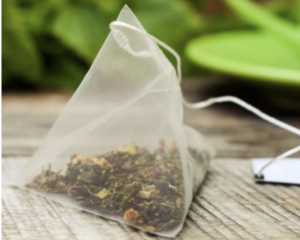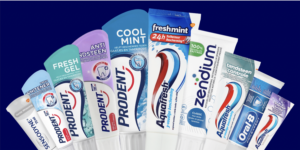Most of the plastic made in the world winds up in water where it breaks down into invisible but long-lasting pieces which gets eaten by wildlife. The bodies of fish, clams, crabs, and other water critters consume these microplastics contain plastic they ate. Bigger fish eat the little fish, you eat the big fish and when you eat the seafood, you also get a dose of plastic.[2]
No charge will appear on your bill - but you will pay for it in your healthcare bills.

If you ordered hot tea with dinner, things could get worse because a surprising number of brands of tea have plastic in the teabag dissolving astounding amounts of invisible microplastics into the hot tea water which wind up in your tummy.[3],[4]
Back home, as you all prepare for bed, you brush your teeth and make sure your kids brush theirs. You thought you were practicing good healthcare hygiene – but some brands of toothpaste have tiny bits of plastic put there on purpose to absorb dye in order to create the colored strips that make it attractive to buyers in the supermarket.
Regardless of whether any of the plastic you swallowed was invisible or not, it harms the health of your family in two major ways. First, the tiny particles act like a tennis ball thrown in a dirty puddle. In their journey through polluted water and the bodies other living things, the little surface hairs work like Velcro and pick up and concentrate all sorts of very toxic chemicals which had been previously diluted in the water.
Tiny invisible plastic acts like a clean-up sponge in the environment. This sounds good until you eat the sponge. When you swallow these invisible plastic dirty particles pieces, you bring those poisons into your body.
Second, the plastic itself seems to upset the way your body works. Studies of lung cancer, liver failure, and digestive system all point to this.
[8] Unfortunately, there has been very little money made available to researchers to allow them to be clear on that.
You not only consume plastic, but you also excrete it. One study involved volunteers who donated their human waste for examination. The scientists found 30 pieces of micro-plastic in every teaspoon of solid waste examined.
[9] Your human waste goes down the sewer to the local sewage treatment plant, and then back into the river to the next town.
The bottom line is that we have an uncontrolled industrial process that is creating a health risk for every citizen on earth. – and we know it.
The entire world’s plastic production in 2018 was around 100 pounds for every citizen of the world, and the the rate of production is doubling every 11 years.
[10] Depending on the kind of plastic, their life expectancy can be 10-20 years for a plastic bag, around 450 years for a bottle, and up to 1,000 for other thicker plastic materials.
[11]So much plastic is now in the oceans that there is a concentration of it between California and Hawaii that is bigger than Australia called the Pacific Gyre Garbage Patch.
[12] Six other floating plastic dumps are also so large (and growing) that they are visible from satellites looking down on the earth.
A less direct but equally important issue is the contribution plastics make to climate change. In 2019, the production and incineration of plastic was calculated to produce an amount of greenhouse gasses equivalent of the emissions from 189 five-hundred-megawatt coal power plants.
[13]One major problem is that existing government regulation makes protecting the public health your problem. This means a company can make whatever it wants, and once you buy the bottle of water or bag of salad greens, they have handed you the responsibility to dispose of it in a way that does not harm others.
For the vast majority of all plastics, no such method of disposal exists.
The only current solution is to require that plastics be made using natural ingredients that can melt back into the ground and water without causing harm. No regulations have been put in place to make that happen. Why is that?
Follow the money.
The source of the current ingredients used to make plastics come from oil and gas companies. They fear regulation and reduction in sales of oil and gas due to climate change regulation, so they are diversifying their product lines into plastic production.
[14]The World Health Organization (WHO) has been working since 2016 to get a multi-national team of experts in place to study both the size of the plastic pollution problem and possible solutions. In April of 2020, The White House announced that it was suspending America’s contributions and leaving the organization.
[15]You can lower your family’s intake of plastics. Stop buying water in plastic bottles or using plastic take- out drinking cups. Do not microwave food in plastic containers or place plastic-wrapped food in boiling water. Use paper bags when grocery shopping.
To solve this crisis we have to surface two different problems. The first is making people aware of just how awful and fast-growing a problem this is. The second is by educating others about how industry has created a situation where they are not held accountable for the kind of plastic they make, or any of the harm it causes.
We have to make the invisible visible. Please forward this, post it on social media pages, and discuss it with your family.
Authored by Francis Koster Ed. D
[10] Geyer, R., Jambeck, J. R., & Law, K. L. (2017). Production, use, and fate of all plastics ever made. Science Advances, 3(7), e1700782.

